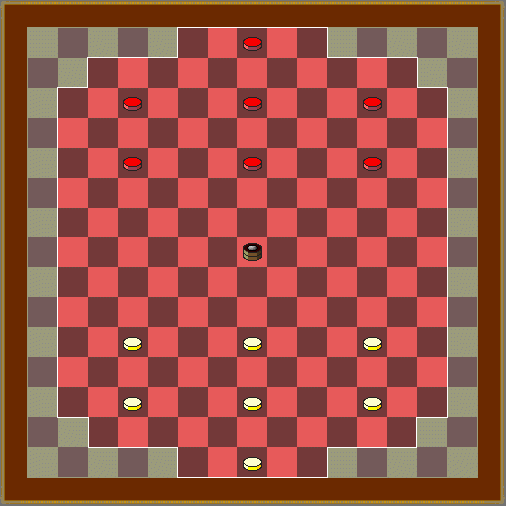

Seven Sages is an unorthodox board game. The Sages try to kick the Fool into the goal on the opposite side. This
wins the game. Pieces cannot be captured. A Sage slides in all directions, except diagonally southward. However, if
the Fool is located diagonally southward, the Sage may move there to kick the Fool. A Sage slides and stops on a
square in front of the Fool, which immediately continues in the same direction. The Fool can only be kicked in a
direction which leads either to another Sage (of either colour) or the goal. (If this isn’t the case, the Fool
will not move when a Sage moves to kick him.)
Upon colliding, the Fool either bounces back toward the kicking Sage or deviates 90 degrees, in either of the two
perpendicular directions. It may then continue to bounce on other Sages, but can now only deviate in the
perpendicular directions. Only the first bounce is obligatory. The Fool may stop anywhere on the later legs.
Importantly, the Sage can kick a Fool on an adjacent square by displacing it. (Otherwise, the Sage stops
immediately before the Fool.) The Fool cannot move into the margin squares; but a Sage can move there. No more than
one Sage can enter the friendly goal. A Sage cannot enter the enemy goal, but can pass over it. In the original
rules, the first to score five points wins.
 Here, White can kick the
Fool all the way into the Red goal. The Fool will bounce back to the kicking Sage. Then it deviates to the left and
hits the leftmost Sage. From there, it goes directly into the Red goal.
Here, White can kick the
Fool all the way into the Red goal. The Fool will bounce back to the kicking Sage. Then it deviates to the left and
hits the leftmost Sage. From there, it goes directly into the Red goal.
Discussion
According to the original rules, the Sage always takes the Fool’s place when kicking it. But this means that
it’s possible to stop the enemy from kicking the Fool by placing a Sage immediately behind the latter. In this
version, it can still be kicked to the sides. Moreover, when the Fool bounces back on the kicking Sage, there is one
more square to land on. I believe this version makes the game more lively, and there’s no reason to have the
kinds of restrictions on piece configurations as in the original rules.
The original rules are better played with a rule amendment: The Fool may be lobbed over a Sage that blocks the Fool.
The latter lands on an empty square behind the blocking piece. This can only occur if the kicking Sage is positioned
next to the Fool, on the other side. In this way the Fool cannot be blocked easily. After the lob, the Fool stays
where it lands and does not continue to bounce. This variant has also been implemented. Alternatively, the Fool
deviates 45 degrees instead of 90 degrees. This makes the game harder.
Seven Sages (“Les 7 sages”) was designed by Max Gerchambeau in 1980, and published by
Jeux Robert Laffont in 1981. (“Bounce sound” by Mike Koenig, Soundbible.com, here.)
References
‘Les 7 sages’. BoardGameGeek. (here)
‘Max Gerchambeau’. Wikipedia article. (here)
‘7 Sages’. (here)
☛ You can download my free Seven Sages program here (updated 2018-10-04), but you must own the software Zillions of Games to be able to run it. (I recommend the download version.)
© M. Winther, 2018 September